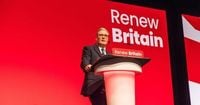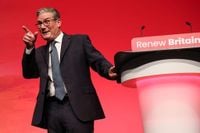In the echoing halls of Liverpool’s convention center, the Labour Party gathered for its annual conference—a meeting marked by tension, introspection, and, for many, a sense of foreboding about the party’s future. Less than 15 months after Keir Starmer led Labour to a landslide general election victory, the mood among delegates, MPs, and observers was anything but triumphant. Far from basking in the glow of their historic 172-seat majority, party members found themselves grappling with internal strife, plummeting poll numbers, and a government struggling to deliver on its promises.
According to the Byline Times, one of the most striking images of the Liverpool conference was the sheer imbalance between party members and corporate lobbyists—a visual metaphor, perhaps, for a party increasingly seen as detached from its grassroots. The lack of meaningful votes and the exclusion of left-wing journalists for vaguely defined reasons only fueled the perception that Labour’s leadership had become insular, hyper-factional, and intolerant of dissent. “The party’s problems go back to the origins of the Starmer project,” the paper observed, pointing to Morgan McSweeney, now the Prime Minister’s Chief of Staff, as the architect of a strategy dubbed ‘Corbynism without Corbyn.’
This approach—rooted in the belief that Labour needed a more professional, less radical face after the 2008 financial crash—helped Starmer secure the leadership. The Byline Times detailed how Labour Together, a think tank then led by McSweeney, funded exhaustive polling to demonstrate that members wanted a left-wing but competent leader. Once Starmer was installed, however, the very members who propelled him to power found themselves marginalized. Mass expulsions, rigorous candidate vetting, and a culture of rule-bending for factional advantage became the new norm. “This level of factionalism is unprecedented in the party’s history,” the paper argued, noting that previous Labour factions—Blairites, Corbynites, and others—at least tolerated competing views. Today’s leadership, it claimed, has “almost no breadth, no air to breathe, no creativity, little imagination, almost no challenge and virtually no accountability.”
The consequences of this internal strife are now playing out on a national stage. As The Hill reported on October 3, 2025, Starmer’s net favorability rating has plummeted to minus-50, making him one of the most unpopular democratic leaders with his own voters. Despite Labour’s landslide win in July 2024, the party’s share of the vote increased by a mere 1.6 percent, with only about a third of the electorate backing Labour—more out of frustration with the Conservatives than genuine enthusiasm for Starmer’s vision. Economic growth remains stagnant, illegal immigration has risen contrary to campaign promises, and scandals have claimed two Cabinet ministers, including Deputy Prime Minister Angela Rayner.
The government’s woes have been compounded by the meteoric rise of Nigel Farage’s Reform UK party. Reform UK, which captured nearly 15 percent of the popular vote in 2024, has since soared to around 30 percent in the polls, consistently outpacing both Labour and the Conservatives. Labour, by contrast, has stagnated at about 20 percent, with Starmer increasingly seen as either a figure of ridicule or an object of scorn among voters. As The Hill put it, “His party’s polling numbers have collapsed to barely two-thirds of the unusually low support it won at the election.”
Yet, for all the turmoil, Starmer’s government appears likely to endure—at least in the short term. The constitutional machinery of British politics means that, barring a successful vote of no confidence or a major rebellion by Labour MPs, the next general election isn’t due until the summer of 2029. With Labour holding 399 seats (plus nine suspended MPs likely to support the government), it would take a significant revolt—about 80 MPs—to trigger a leadership contest, an unprecedented move for Labour since 1922. As The Hill noted, “Forcing a general election would be political suicide” given Labour’s current polling woes.
Amid this backdrop, the Institute for Government (IfG) provided a detailed analysis of the conference, highlighting both the challenges and the limited opportunities facing Starmer’s team. The prime minister’s speech, according to IfG, focused on two main themes: countering the threat from Reform UK and driving reform of public services. Starmer declared that “the defining mission of this government is to grow the economy” as a way to improve living standards and outmaneuver Farage’s insurgent party. Policy announcements on immigration and student grants were made, but the real meat—especially on tax and spending—was left for the upcoming budget on November 26, 2025.
Starmer’s Cabinet has undergone a recent reshuffle, with new ministers still settling into their roles. Darren Jones, newly appointed as Chief Secretary to the Prime Minister and Chief Minister in the Cabinet Office, was singled out by IfG as having the greatest capacity to overhaul how government operates. While there was optimism about the cohesion of Starmer’s inner team, there were also concerns that Jones could be stretched too thin to focus effectively on his No.10 responsibilities.
Fiscal policy loomed large over the conference, with widespread expectations that the economic and fiscal forecasts for the UK will look worse at the November budget. Chancellor Rachel Reeves is likely to be forced to announce new tax rises to meet her fiscal rules, but ministers avoided making any firm commitments at the conference. “Our economic renewal will rest on stability, to keep taxes…as low as possible,” Reeves said in her speech, according to IfG. Nonetheless, there was speculation about whether Labour might abolish the two-child limit on means-tested benefits—a move that would cost an estimated £3.5 billion and complicate the fiscal challenge even further.
Business leaders, for their part, are taking a wait-and-see approach. While Labour has published promising strategies for business over the past year, corporate Britain is looking for concrete action, particularly regarding business taxes, energy costs, and labour regulation. As IfG noted, “Warm words are nice—conference was pleasingly unmarred by populist digs at the business world—but everyone is waiting for concrete action before delivering a firm verdict.”
On energy policy, Ed Miliband and his team doubled down on Labour’s commitment to clean power, emphasizing the importance of renewables both for job creation and for keeping energy bills down. Miliband accused Reform of “breaking the climate consensus by importing culture wars from the US,” underscoring the increasingly contentious nature of net zero politics. The government has made progress in identifying projects to deliver its clean power goal by 2030, but questions remain about whether these efforts are moving fast enough—and whether consumers will see tangible benefits before the next election cycle.
For all the talk of missions and resets, the underlying reality is stark: Labour’s internal divisions and Starmer’s personal unpopularity have left the party vulnerable at a critical juncture. The exclusion of left-wing voices, the lack of a clear narrative on tax and spending, and the specter of Reform UK’s rise all point to a government at risk of losing its way. As the Byline Times warned, “One-sided and lopsided projects—especially in politics—become blindsided.” If Labour is to avoid the “ragged rocks of Reform and Farage,” it will need not just a change of captain, but a fundamental shift in its culture—toward greater openness, creativity, and respect for pluralism.
The months ahead will test whether Starmer’s Labour can adapt and deliver—or whether the cracks exposed in Liverpool will widen into a full-blown crisis before the party returns to conference next year.





